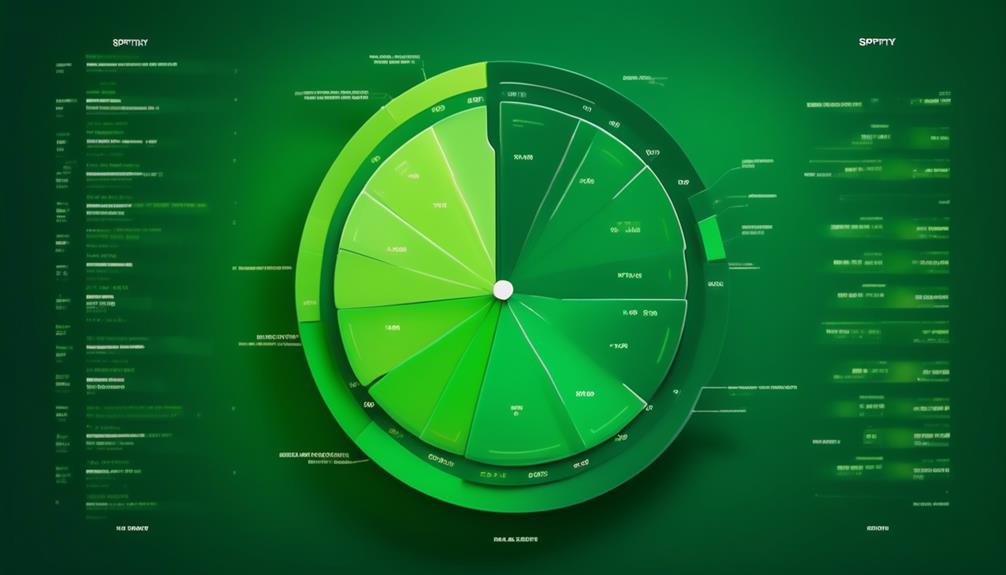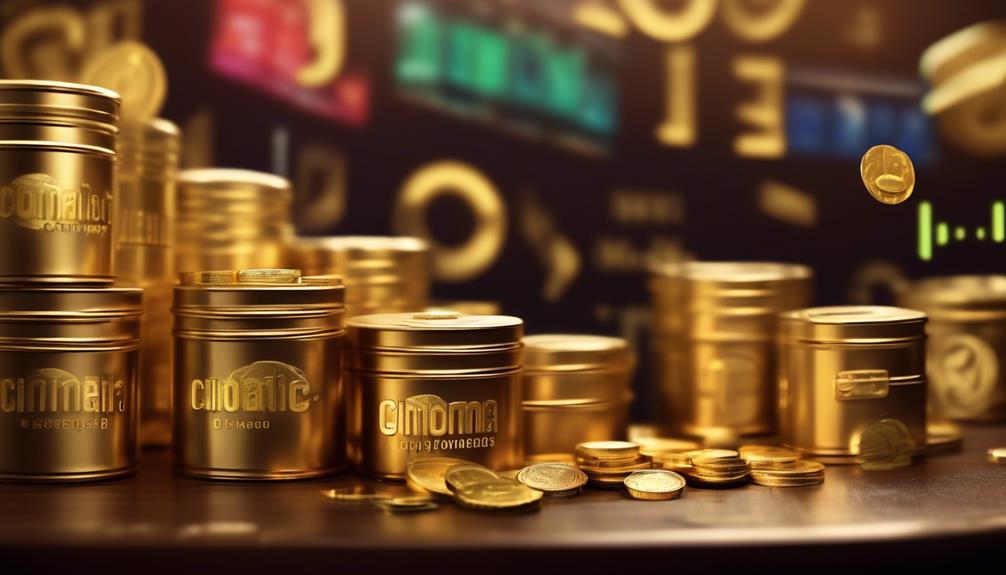
How much money is 1 million streams on Spotify?
Like the elusive pot of gold at the end of a rainbow, the exact payout for one million Spotify streams seems to be shrouded in mystery.
You’ve probably wondered just how much an artist earns when their song hits that coveted million-stream mark. It’s quite a puzzle, isn’t it?
Well, let’s put on our detective hats and start unraveling this enigma. We’ll dissect Spotify’s business model, explore the impact of geographical location, and delve into the role of record labels.
But brace yourself, the answer might not be as straightforward as you’d hope.
Key Takeaways
- Spotify pays artists approximately $0.0032 to $0.005 per stream, but the final amount received by the artist is a fraction of the initial per-stream payment.
- Geographical location can influence streaming rates on Spotify, with currency conversion rates and regional listener behavior playing a significant role.
- Record labels play a crucial role in securing favorable conditions for artists, leveraging industry connections, and providing resources and networks.
- Maximizing earnings on Spotify involves engaging in royalty negotiations, leveraging playlist placements, regularly releasing new music, promoting on social media, and using Spotify’s analytics for valuable insights.
Understanding Music Streaming

Diving into the world of music streaming, you’ll find that it’s a complex, dynamic landscape that’s constantly evolving and redefining the music industry. Streaming technology is the engine of this transformation, driving a paradigm shift in how music is distributed, consumed, and monetized. It’s a radical departure from traditional models, offering limitless, on-demand access to a vast, global library of music.
Understanding playlist algorithms is crucial to navigating this new terrain. These sophisticated, AI-driven systems curate personalized content, shaping user listening habits and influencing trends. They’re not just random sequences, but powerful tools that decide what gets heard and what fades into obscurity. It’s a democratic process, but also a competitive one, that can make or break an artist’s career.
In this arena, data is king. Metrics like play counts, user engagement, and social media buzz all feed into these algorithms, determining track visibility and artist popularity. Thus, understanding these dynamics is key to success in this space.
Spotify’s Business Model
Consider how Spotify generates revenue and structures artist compensation. Knowing that the platform’s financial sustainability hinges on a delicate balance of subscription fees, advertisement income, and fair remuneration for musicians, you’ll grasp how complex this business model truly is.
You’ll find it fascinating how these interplaying factors dictate the success of a million-stream song on Spotify.
Revenue Generation Strategy
To fully grasp how Spotify generates revenue, it’s crucial to understand its unique business model that has successfully garnered over 345 million active users worldwide. This model centers around two primary revenue streams: subscription models and advertiser partnerships.
- Spotify offers several subscription tiers, from free access with ads to premium plans without ads.
- Advertiser partnerships allow businesses to reach Spotify’s vast user base through targeted ads.
Premium subscriptions offer additional features like offline listening and high-quality streaming, enticing users to upgrade.
Spotify also partners with artists and labels for exclusive releases, driving user engagement and retention.
Lastly, Spotify’s data-driven algorithms personalize user experiences, fostering loyalty and increasing potential revenue.
This multifaceted approach is what ensures Spotify’s continued growth and profitability in a highly competitive market.
Artist Compensation Structure
While understanding Spotify’s revenue generation strategy is a crucial part of the puzzle, it’s equally important to grasp how artists are compensated under this business model.
Spotify pays royalties based on the number of streams as a proportion of total songs streamed, but the exact amount can vary. Contract negotiations between Spotify and the artist’s record label also play a significant role in determining the final payout.
These negotiations can influence the royalty calculations, often favoring well-established artists over newcomers. Therefore, while Spotify’s platform allows artists to reach a global audience, the complexity of its compensation structure can make it challenging for emerging artists to earn substantial revenue.
Breakdown of Spotify’s Payouts

How much does Spotify actually pay for those 1 million streams you’ve racked up? While the answer isn’t straightforward due to the complex nature of royalty distribution, it’s essential to understand the breakdown. Now, there are Spotify controversies around the fairness of their payout rates, but let’s focus on the numbers for now.
Here’s a simple breakdown of Spotify’s payouts:
- For every stream, Spotify pays about $0.0032 to $0.005.
- This amount is split between the rights holders, including record labels, publishers, and distributors.
- The artist’s share largely depends on their contract terms with the record label.
- Spotify also withholds a percentage, reportedly around 30%, for its operational costs.
- The final amount that reaches the artist is thus a fraction of the initial per-stream payment.
However, this model is subject to continuous innovation, with the platform constantly experimenting with new payout structures to address the controversies and better serve both listeners and artists.
Impact of Geographical Location
Consider how geographical location impacts streaming rates on Spotify.
A key factor is the currency conversion rates that greatly influence the earnings from different countries.
Moreover, regional listener behavior, which varies greatly from one location to another, can significantly shape your streaming success.
Streaming Rates by Country
Often, your geographical location significantly impacts the streaming rates on Spotify, with some countries paying more than others due to various influencing factors. These factors, such as global streaming disparities and streaming legislation differences, can result in drastic contrasts.
- In the U.S., a high-income country, artists earn roughly $0.00331 per stream.
- Swedish artists earn slightly less, with a rate of about $0.00327 per stream.
In contrast, Argentina, an emerging market, pays about $0.00121 per stream. India pays even less at $0.00075 per stream. Australia, another high-income country, pays about $0.00302 per stream.
These disparities highlight the need for a more equitable streaming model, ensuring artists worldwide can benefit from their creativity and hard work.
Currency Conversion Factors
While these streaming rates may seem disparate, it’s crucial to factor in the role of currency conversion and its impact on earnings from various geographical locations. Exchange rate impact can significantly alter the dollar value of your Spotify streams, depending on where your listeners are.
Consider the table below:
| Country | Exchange Rate | Stream Earnings in USD |
|---|---|---|
| Australia | 0.73 | 0.0032 |
| Canada | 0.80 | 0.0041 |
| Euro Zone | 1.18 | 0.0051 |
| UK | 1.37 | 0.0059 |
| Japan | 0.0091 | 0.00004 |
Moreover, with the rise of digital currencies, the influence of cryptocurrency on the music industry cannot be ignored. It can potentially revolutionize how artists are paid, offering more control over their earnings. Hence, understanding these factors is key to maximizing your streaming revenue.
Regional Listener Behavior
Understanding the impact of geographical location on your streaming success is essential, as regional listener behavior can significantly influence your overall earnings on platforms like Spotify.
Consider these aspects:
- Listener demographics: The age, gender, and lifestyle of listeners in a region can shape the type of music they stream.
- Cultural influences: Distinct music tastes can exist within different cultures, impacting your song’s popularity.
- Time zones: Peak streaming times vary across the globe, affecting when your music is played.
- Accessibility: Internet availability and streaming platform access can dictate listener numbers.
- Local music policies: Certain regions might promote local artists more, impacting international streams.
Role of Record Labels
In the labyrinth of music streaming, record labels play a critical role in influencing an artist’s journey to 1 million Spotify streams. It’s through label negotiations that artists can secure favorable conditions that boost their streaming numbers. Labels leverage their industry connections and promotional capabilities to gain maximum exposure for an artist’s work.
Yet, the rise of digital platforms has also opened up new avenues for artist independence. Now, you can bypass traditional gatekeepers and release your music directly to the masses. You have more control over your work and can keep a larger share of the revenue.
However, it’s important to remember that labels offer more than just a route to fame. They provide resources, expertise, and networks that can be invaluable to emerging artists. But their involvement also means a slice of your streaming revenue goes to them.
Ultimately, the role of record labels in achieving 1 million Spotify streams is a double-edged sword. It depends on the artist’s individual circumstances and aspirations. While some may thrive with a label’s backing, others might find success in carving their own path to a million streams.
The Artist’s Cut

Navigating the labyrinth of label negotiations and digital independence, you’ve now reached the crux of the matter – your cut from those 1 million streams on Spotify. It’s essential to grasp the complexity of royalty negotiations and the potential benefits of direct licensing, to optimize your earnings.
- Royalty negotiations can be intricate. It involves dissecting the terms agreed upon with your label, the distributor, and Spotify itself.
- Direct licensing, on the other hand, bypasses the traditional record label setup. You negotiate directly with Spotify for your royalties.
The artist’s cut from streaming varies significantly depending on royalty rates and contract specifics. Typically, you’d receive somewhere between $0.003 and $0.005 per stream. Hence, one million streams could earn you between $3,000 and $5,000.
However, after label deductions and other costs, you might end up receiving only around half of this amount.
Case Study: Real-life Examples
Let’s dive into some real-world examples to illuminate how these royalties play out in the lives of artists, both established and emerging. Consider the case of an up-and-coming indie band that managed to hit a million streams. They implemented strategic stream marketing strategies, such as playlist placements and social media campaigns, to boost their visibility. Despite the impressive stream count, their earnings from Spotify merely amounted to around $4,000.
Next, let’s examine a well-known artist with a dedicated fan base. Their million streams came primarily from loyal listeners, reflecting a high fan engagement impact. Yet, even with their popularity, Spotify royalties only added approximately $7,000 to their income.
These examples offer a stark reality check. Artists may celebrate reaching a million streams, but the financial impact can be underwhelming. It underscores the importance of diversifying income streams and not relying solely on platform royalties. While stream marketing strategies can boost exposure, and fan engagement can sustain an artist’s career, the actual earnings from Spotify streams mightn’t be as lucrative as one might expect.
Therefore, artists need to innovate, exploring other revenue channels like merchandise, touring, and direct fan patronage.
Comparing Spotify to Other Platforms

Consider the revenue differences across various platforms, not just Spotify.
How does Spotify’s streaming rate stack up against its competitors?
Analyzing these disparities can provide you with a clearer understanding of how beneficial it could be to surpass the 1 million streams mark on Spotify compared to other platforms.
Revenue Differences Across Platforms
When comparing Spotify to other platforms, you’ll find there’s a significant variance in the revenue artists can potentially earn. Factors such as platform exclusivity and ad-supported streaming play a vital role in these differences.
- Apple Music, for example, pays artists more per stream but lacks a free tier.
- Tidal, known for its high-fidelity sound, offers exclusivity deals that can be lucrative for artists.
- YouTube’s ad-supported model results in lower per-stream payouts, but its vast user base can generate substantial revenues.
- Amazon Music offers both ad-supported and premium tiers with differing revenue structures.
- Pandora, a radio-style platform, has a unique payment system based on ‘spins’ rather than streams.
Understanding these variations can help you navigate your musical journey more effectively.
Streaming Rates: Spotify Vs Others
Having explored the variations in potential earnings across different platforms, you might be wondering how Spotify’s streaming rates stack up against those of its competitors.
Spotify’s paid subscription tiers contribute to higher streaming rates, which can be beneficial to artists. However, other platforms like Apple Music and Tidal often pay more per stream, regardless of subscription tier.
Playlist placement can also drastically affect earnings on Spotify. Songs featured on popular playlists receive more streams, boosting potential revenue. Despite this, Spotify’s lower per-stream rate can make achieving comparable earnings more challenging.
It’s crucial to consider these details when assessing your potential earnings from streaming platforms. Striking a balance between maximizing streams and optimizing revenue is key in this digital music landscape.
Tips for Maximizing Earnings
To maximize your earnings from Spotify’s one million streams, it’s crucial to understand the platform’s payment structure and leverage its features effectively.
Spotify’s payment system is based on a pro-rata model, and the payout per stream can vary. However, you can negotiate your royalties, which is a key factor in ensuring a higher income.
Here are some strategies to maximize your earnings:
- Engage in royalty negotiations. This can be a complex process, but it’s worth the effort. Higher royalties mean more income per stream.
- Leverage the playlist feature. Being featured on popular playlists can significantly increase your streams.
- Regularly release new music. Spotify’s algorithm favors artists who frequently release new tracks.
- Promote your music on social media. A strong online presence can drive more listeners to your Spotify tracks.
- Use Spotify’s analytics. These tools can provide valuable insights into your audience and help you tailor your content.
Future of Streaming Revenues

As we peer into the future, it’s clear that streaming revenues are poised to play an even more vital role in the music industry’s economic landscape. Streaming legislation is among the key factors that will shape this landscape. It’s expected that there will be tighter regulations to ensure fair compensation for artists.
Digital Rights Management (DRM) will also be a game-changer. DRM technologies help protect copyright, ensuring that artists are paid for their work. The future will likely see more robust DRM systems, reducing piracy and increasing revenues.
Consider the potential changes in this handy table:
| Factor | Expected Change |
|---|---|
| Streaming Legislation | Tighter Regulations |
| Digital Rights Management | More Robust Systems |
Now, you might wonder how these changes will affect you as an artist. Increased regulation and improved DRM systems mean you’ll likely see an upturn in your streaming revenues. But, it’s important to stay informed and proactive, understanding these changes and adapting your strategy accordingly.
Innovation is key in this ever-evolving industry, and those who can’t adapt risk being left behind. So keep your eyes on the future of streaming revenues, and let your music play.

